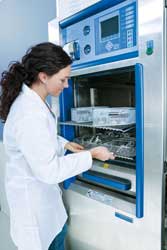
Posted to News on 10th Aug 2011, 23:53
Multi-functional valve block for steam sterilisation systems
Steam sterilisation is the standard method used in most laboratories and hospitals for sterilisation of medical instruments, surgical garments and dressing materials. A key factor for effective sterilisation is that air in the sterilisation chamber must be displaced completely by steam at the correct temperature and quality, and for the required time period.

Complete air evacuation of the autoclave chamber, including in and around the objects to be sterilised, is a basic prerequisite for a reliable steam sterilisation process. Homogeneous temperature distribution is guaranteed only in a 100 per cent steam atmosphere. Any air remaining in the sterilisation chamber mixes with the steam, contributing to the pressure but, importantly, not the temperature of the chamber. An effective method for air evacuation used in modern sterilisation devices is a pulsed vacuum phase, in which the air is removed from the sterilisation chamber and repeatedly 'jolted' from between and within the objects to be sterilised.
For controlling these processes, Burkert has developed a compact system that is based on an innovative multi-functional block design. The concept integrates several Type 2000 INOX 2/2-way seat valves - which have actuators and bodies of high-quality 316L stainless steel - plus associated ancillaries, on a multi-functional block, with space-saving and versatile internal gallery layout possibilities. In the assembly of steam sterilisation devices, this approach eliminates the complex and time-consuming process of assembling the required valves, sensors, strainers and check valves by means of pipe interconnections and elbows.
Customer benefits
Burkert's compact block arrangement saves time and costs, with respect to initial outlay and installation, as well as requiring less installation space. In addition to the capability of developing more compact devices, this latest system from Burkert, dispensing with external pipes, joints and connections, offers higher functional reliability and process availability, since many potential weak spots for leaks are eliminated.
As a result of connecting innovative modular valve bodies using orbital welding, Burkert has further advanced the concept of a complete system for steam sterilisation. The benefits of a compact, prefabricated and cost-effective system from one source are, therefore, not only sustained, but also consistently developed. The very latest welded system is said to be more flexible and more intelligent than the 'traditional' single machined block designs, while being lighter and often more cost-effective. The valve bodies can be combined with actuators from Burkert's Classic and Element ranges, which can, in turn, offer additional features such as position feedback and modulating control.
Typical application
In a sample application, described below, a Type 2000 INOX block controls the connections on the bottom of the sterilisation chamber. It is typical for one block mounted above the chamber to control the steam to the chamber, door seal and jacket, and another block below the chamber to control the evacuation of the chamber. In the following description, it is this essential process that the Type 2000 INOX block is controlling.
In the first process phase, air is removed from the chamber and also crucially within and around the objects to be sterilised. After checking the chamber door seal is air-tight, the Type 2000 INOX valves open to allow the connected vacuum pump to evacuate the air from the chamber. Shortly afterwards they close, and steam is introduced by means of the top block - and the pressure in the chamber returns to atmospheric pressures. This 'saw-tooth' process is repeated several times, with the pressure in the chamber typically pulsating between 250-300mbar absolute and atmospheric pressures. This facilitates the release of trapped air bubbles in the porous textile surfaces, between the items to be sterilised and from the far corners of the chamber. The chamber or connected elements may not be completely free of leak potentials, and thus it is possible that air can be drawn into the chamber by the very phases designed to remove it. This is partly why the evacuation process is repeated over several phases, including several positive pressure pulses above atmosphere.
During the sterilisation process the Type 2000 INOX valves on the block remain closed to keep the steam trapped inside the chamber. The steam pressure in the chamber rises to the level required for sterilisation - typically 3100mbar absolute, a temperature of 134degC. Once the required sterilisation temperature is confirmed by a temperature sensor in the condensate (water) drain area (the point at which the temperature is likely to be at its lowest) the Type 2000 INOX valves remain closed and help maintain the temperature in the chamber for a period of three to four minutes.
This is followed by the drying phase, during which a low-flow Type 2000 INOX valve opens and shortly afterwards is joined by a full-flow valve in parallel, for a first gradual and then faster evacuation of the chamber. This is to evaporate off and hence dry the sterilised objects, by reducing the pressure in the chamber to below the vaporisation point of any condensate present. Reduction of the pressure to typically 40mbar absolute ensures that all remaining moisture is returned to steam, and thus evaporated from the surface of the sterilised objects. After completion of the drying process the valves on the block close to allow the pressure in the sterilisation chamber to return to the normal level by the introduction of ambient air to the chamber. The sterilisation process is then complete and the chamber door can be opened.
Free training courses in steam technology
Burkert is offering an ongoing programme of free educational training courses in steam engineering and management. The courses cover topics such as:
- An Introduction to Steam
- Steam and Condensate systems
- Pressure Reducing and Heat Transfer Systems
- Sterilisation
Engineers wishing to attend the courses are invited to contact Helen Christopher, Burkert UK Marketing Manager, on +44 (0)1453 731353 or [email protected].
Fluid Control Centre
1 Bridge End
GL7 1QY
UNITED KINGDOM
+44 (0)1285 648720






























